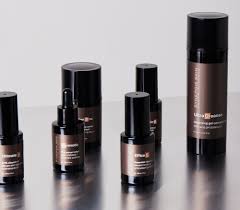
Can You Use Alpha Lipoic Acid with Niacinamide? A Guide to Skincare Synergy
In the world of skincare, antioxidants are key players. They fight off free radicals, support skin health, and reduce visible aging. But not all antioxidants are created equal.
Among the most powerful is alpha lipoic acid (ALA), known for its exceptional antioxidant potency. In fact, it’s reported to be over 40,000% more effective than a combination of vitamins C and E.
That’s a big claim—but what does that really mean for your skin? And more importantly, can you safely pair alpha lipoic acid with niacinamide, another popular skincare hero? Let’s explore.
What Is Niacinamide?
Niacinamide, also known as vitamin B3, is a water-soluble vitamin used widely in skincare. It’s a multi-tasking powerhouse suitable for nearly all skin types.
It helps reduce fine lines, improve skin elasticity, and enhance hydration. It also strengthens the skin barrier, helping skin retain moisture and resist environmental stress.
Niacinamide works as a humectant, meaning it draws moisture from the air into your skin. Once it’s there, it locks it in, reducing water loss and boosting hydration.
This extra moisture keeps your skin looking plump, smooth, and healthy. But niacinamide does more than just hydrate.
It also contains anti-inflammatory properties, making it a go-to for those with sensitive, dry, or irritated skin.
Even if you have oily or acne-prone skin, niacinamide can help. It regulates sebum production and reduces the appearance of pores, giving you smoother skin and fewer breakouts.
If you’re new to this ingredient, there’s plenty of research and anecdotal support behind its long-term benefits.
What Is Alpha Lipoic Acid?
Alpha lipoic acid (ALA) is a naturally occurring compound produced by the body. It helps generate cellular energy and acts as a potent antioxidant.
ALA is unique because it’s both water- and fat-soluble, meaning it can work in all areas of the skin and body.
This makes it incredibly effective at neutralizing free radicals and reducing oxidative stress at a deep cellular level.
ALA can be taken as a dietary supplement or applied topically via skincare products. You’ll also find it in foods like spinach, broccoli, red meat, and tomatoes.
When taken internally, it supports full-body health. When used on the skin, it can help with fine lines, dullness, and skin texture.
However, there’s a catch—topical alpha lipoic acid increases sensitivity to sunlight. This means it’s crucial to use SPF daily if ALA is part of your routine.
Neglecting sun protection while using ALA can result in burns, hyperpigmentation, or long-term sun damage. So always follow with sunscreen.
Can You Use Alpha Lipoic Acid and Niacinamide Together?
Yes, you can safely use alpha lipoic acid with niacinamide, but with some precautions.
There are no known negative interactions between these two ingredients, making them a safe and effective duo in your skincare routine.
They can complement each other well—niacinamide hydrates and regulates oil, while ALA provides powerful antioxidant protection.
However, both are active ingredients, so it’s important to monitor how your skin reacts when introducing them together.
If you’re using both in a routine, you might prefer using niacinamide in the morning and alpha lipoic acid at night to avoid overstimulating your skin.
Alternatively, use them on alternating days to give your skin time to adapt. Always start slow and build tolerance gradually.
What Should You Not Mix with Niacinamide?
Niacinamide is a versatile ingredient, but there’s one key ingredient to be cautious with: vitamin C (ascorbic acid).
Although both are antioxidants, they may neutralize each other when used at the same time due to differences in pH.
This can make them less effective and potentially irritate the skin, especially if you’re sensitive.
To avoid this, consider using vitamin C in the morning to brighten and protect, and niacinamide in the evening to hydrate and repair.
This way, your skin benefits from both without risking irritation or reduced efficacy.
What Should You Not Mix with Alpha Lipoic Acid?
Unlike niacinamide, ALA doesn’t play well with every ingredient. Its potency and acidic nature can cause skin irritation if mixed with the wrong products.
It’s best to avoid layering it with other strong acids, such as glycolic, salicylic, or lactic acid, especially if you have sensitive skin.
Mixing ALA with retinoids or strong exfoliants can also increase the risk of irritation, peeling, or redness.
Because there’s limited research on product compatibility, it’s best to use ALA on its own or in minimal routines.
When starting out, try ALA every other night and monitor how your skin reacts. Over time, you can adjust based on your skin’s tolerance.
Can You Use Niacinamide Every Day?
Yes, niacinamide is gentle enough for daily use, even twice a day. It’s well-tolerated and works synergistically with many ingredients.
It can even be paired with actives like retinol, AHAs, and BHAs, reducing potential irritation and dryness.
Apply niacinamide after cleansing and before moisturizing. Its water-soluble formula allows it to absorb quickly and penetrate deeply.
Over time, it supports long-term skin health, including better hydration, improved tone, and a stronger skin barrier.
Can You Combine Niacinamide with Hyaluronic Acid?
Absolutely. Niacinamide and hyaluronic acid make a perfect pair.
Hyaluronic acid acts as a moisture magnet, pulling water into the skin. Niacinamide locks that moisture in and enhances skin texture.
To maximize results, apply hyaluronic acid first, followed by niacinamide. This layering approach keeps skin hydrated, balanced, and plump.
Together, these two can transform dehydrated, dull skin into a dewy, healthy-looking complexion.
Tips for Using Alpha Lipoic Acid and Niacinamide Together
If you’re ready to combine these ingredients, follow these best practices:
Introduce one at a time to avoid overwhelming your skin.
Use ALA in the evening due to its photosensitivity risk.
Apply niacinamide in the morning for hydration and protection.
Always follow with broad-spectrum sunscreen during the day.
Perform a patch test before using ALA for the first time.
Avoid combining ALA with strong acids or exfoliants in the same routine.
Keep your routine simple and minimal to start.
Final Thoughts
Alpha lipoic acid and niacinamide are both powerful skincare ingredients. Each offers unique benefits, and when used correctly, they can complement each other beautifully.
ALA provides unmatched antioxidant protection, while niacinamide offers hydration, oil control, and soothing effects.
Used in harmony, these ingredients can help you achieve brighter, healthier, and more resilient skin.
Just remember: skincare is personal. What works for one person may not work for another. Always listen to your skin and adjust your routine as needed.
And of course, daily SPF is non-negotiable—especially when using ingredients like alpha lipoic acid that increase sun sensitivity.
Want to learn more or share your skincare experiences? Follow us on Instagram for tips, product reviews, and expert Q&As.
Have questions about alpha lipoic acid, niacinamide, or how to build your perfect skincare routine? Drop them in the comments or send us a message—we’re here to help!


